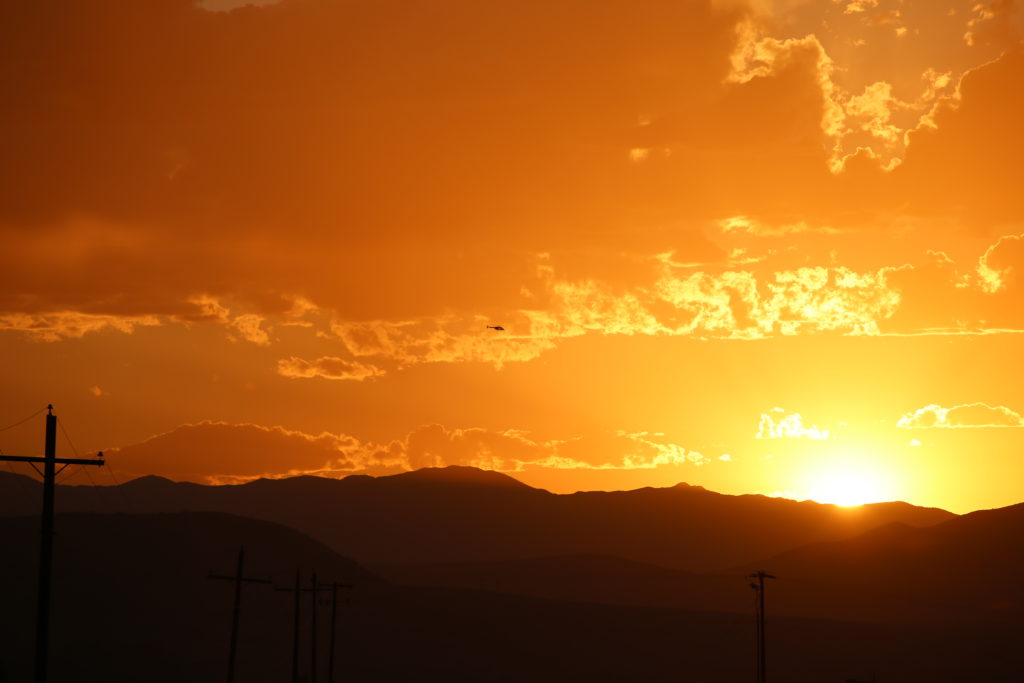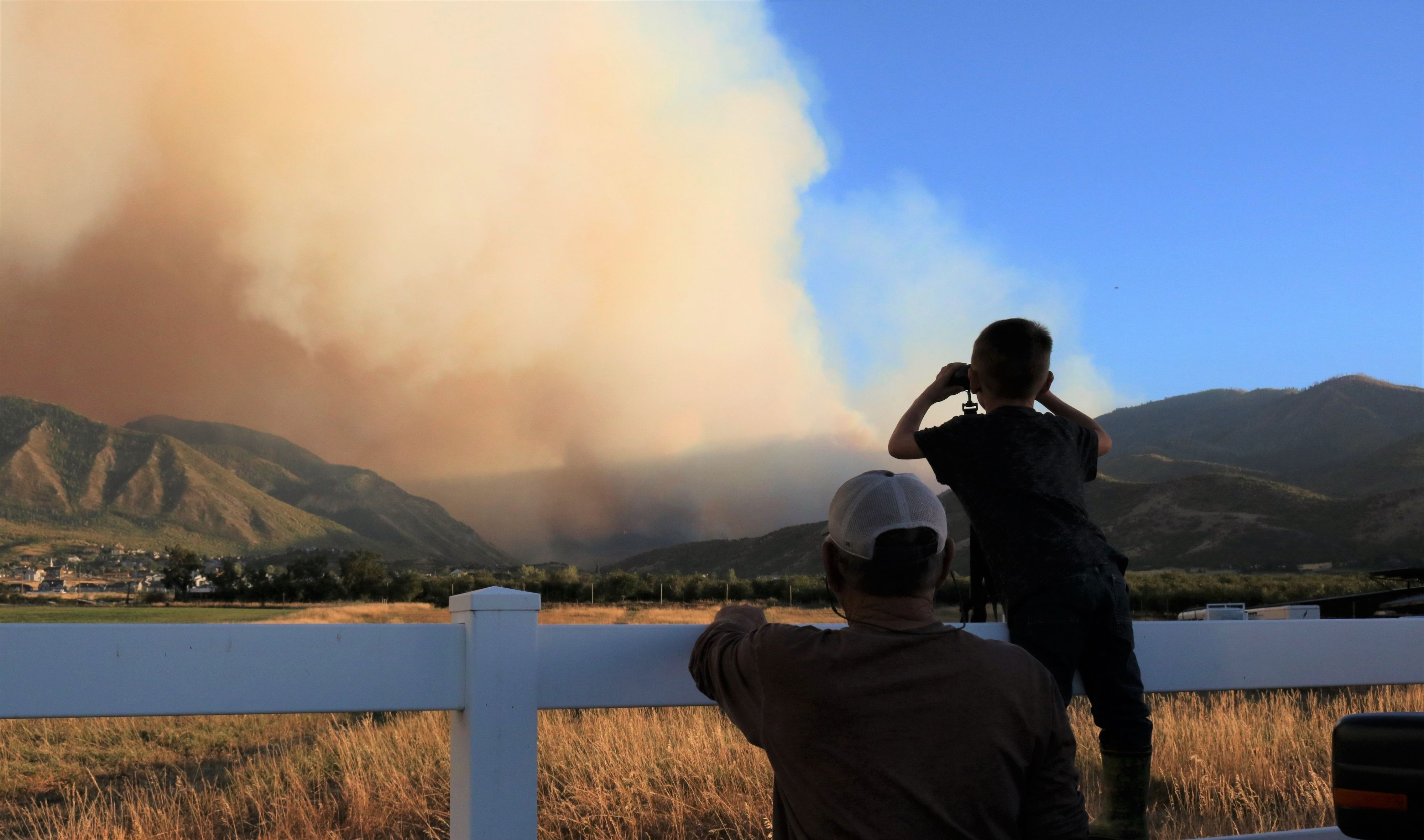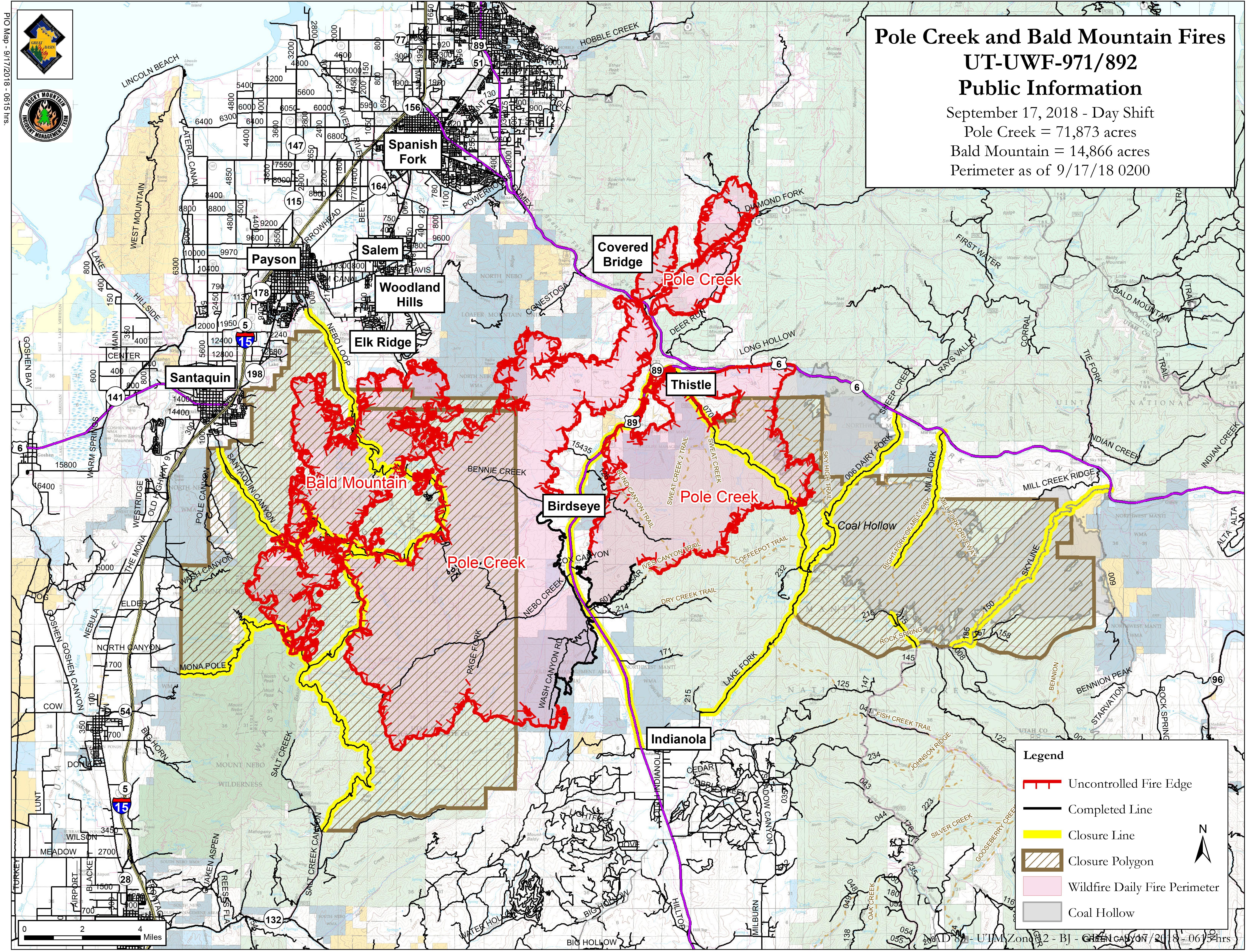
Residents from southern Utah and Juab counties gathered possessions as smoke and emergency personnel pooled into neighborhoods at risk from the Pole Creek and Bald Mountain fires. Since the first communities Covered Bridge, Woodland Hills and Elk Ridge evacuated on Sept. 13, about 6,000 others have been displaced from their homes and forced to flee.
The fires, ignited by lightning strikes on separate dates, cover approximately 83,000 acres as reported by the Utah County Sheriff’s Office on Sept. 17.
Tracy Cowley, her husband and their 18-year-old son were given a pre-evacuation notice Sept. 13 at 1 pm.
Cowley said the family gathered a few bags, boxes and two computers, which held most of their important documents and pictures, as a precaution. They never expected they’d actually need to evacuate their Woodland Hills home.
A few hours later, the family was eating dinner when there was knock on the door. It was a neighbor asking if they were OK. A few minutes later, Cowley said she got a message on her phone telling them to evacuate.
“So we left our house and drove down the hill,” Cowley said.
The family has been staying with her husband’s brother in Orem since.
Cowley said it is now looking like they might not be able to return home for another two weeks. But, she said she hopes their family will have something to go back to.
In a community meeting Sept. 16, Cowley said officials told residents the fire was less than 2 percent contained.

Thanks to her brother-in-law’s support, Cowley said their needs have been mostly emotional as opposed to physical.
Cowley said Salem Hills High School opened their halls to provide shelter and bathrooms. The school has been converted into a crisis center. Tents and trailers are pitched in the parking lots. There, the Red Cross has been providing food and water.
Cowley said the Crisis Center has been a big help for her family as they’ve reeled from the events of the past couple of days. The family drives down to the high school each day to get a meal and touch base with others from the community.
“It is not necessarily fun,” Cowley said. “But I can feel the sense of community that has grown. People are just loving each other and helping each other and holding on to each other.”
As her family attempts to adjust to living in a new place, attends community meetings and keeps their eyes trained to updates, Cowley said she leans on love, emotional support and the knowledge that people really do care about one another.
Twenty-year-old UVU student Cory Rokovitz echoed a similar sentiment. He too was displaced from his Woodland Hills home on Sept. 13.
Rokovitz said it’s been hard but that he feels an unexpected sense of peace. A lot of which he said has to do with his faith, but also because of the support his family has received in the passing days.
He and his family are staying with his grandfather now, but he said he’s been to Salem Hills High School a few times to get meals.
The Red Cross is there, but other volunteers from the community have also been instrumental in providing aid, Rokovitz said. The food is good, and plentiful. His father waited in line for nearly an hour on Sept. 16 because so many people are in need. The line was long, filled with displaced families and snaked around the school.
According to Rokovitz, officers from the officials have been walking around the Crisis Center answering questions.
About Salem Hills High, Rokovitz said school is still in session, but sporting events have been canceled. The air is bad, thick, smoky and compressing, and Rokovitz said it smells like a heavy campfire, especially in the mornings and nights.

As of Sept. 17, other areas like Springville and parts of Spanish Fork have yet to evacuate but are prepared to do so if the fire creeps closer to homes.
Liz Miser lives right below the Spanish Fork reservoir. Behind her house looms the Lone Pine Mountain, the other side of which is ablaze. Partially evacuated communities, Woodland Hills and Elk Ridge lie five miles to the west.
“Everyone in our neighborhood is ready,” Miser said. “We’ve knocked on doors. We’ve made sure everyone has a plan. So, if it does (come), we are ready.”
For now, they wait and hope they don’t join the estimated 6,000 already displaced.
Miser said she’s been trying hard not to fall into a social media trap and get worked up. Although Facebook has been a good resource, Miser said communication is muddled because it is hard to know the difference between fact, rumor and opinion.
Things are bad, Miser said, but perhaps not as bad as some believe.
In her neighborhood, communication has been good, according to Miser. Unlike Woodland Hills and Covered Bridge who only had a few hours to prepare, they still haven’t evacuated despite the pre-notice given on Sept. 13.
Miser said she is grateful.
Still, things have been chaotic, and nerves have jumped up and down with the turning of each day.
The neighborhood has meetings each day, and there is a Facebook page where residents have direct contact with a city official. For the most part, Miser said, those posts come before the information is released on the Spanish Fork community page.
They even practiced a reverse 911 where a text was sent to each home in the neighborhood.
On Sept. 15, Miser said there was a neighborhood meeting where papers were passed out. One red, the other green. The red meaning help is needed, and the green, none is required. Miser explained that should they be evacuated, the papers are to be put on the windows so the police know who to focus on.
Miser said they’ve been told evacuation is unlikely, but it is hard to say. On Sept. 17, she said residents’ nerves jumped up again. The fire is huge, unpredictable and immense — they don’t really know what is going to happen.
The fire jumped U.S. Highway 6 and is heading into Diamond Fork and Hobble Creek canyons, according to an update Miser said she received the morning of Sept. 17.
On Sept. 16, emergency personnel started bulldozing a fire line astride the ridge behind Miser’s house. She was told city officials will continue to do so in case the fire tries to come into the neighborhood. Similar efforts are being echoed in other threatened neighborhoods.
Waiting is not easy, but Miser said she feels the community is ready. They are strong and she can see Utahns banding together.
“I know the Red Cross doesn’t have a lot to do right now because they have too many volunteers,” she said. “It’s been cool.”

Others from the community have pitched in, like Kayla Caldwell and her father. The two made cookies and strapped homemade signs across wire fences.
One read, “Stay safe Woodland Hills” and another “Thank You Firefighters.” The former of which was accompanied by a drawing of two helicopters diving towards leaping flames.
Residents like Miser, Cowley, Rokovitz and their families said they don’t know what is going to happen.
Plumes of gray smoke continue to waft from the mountainsides. Approximately 6,000 individuals have been forced from their homes, a number that is expected to rise. U.S Highway 6 closed again on Sept. 16, and the Utah Highway Patrol said they expect it to remain so for an extended period of time.
In an afternoon press conference on Sept. 17 at the Spanish Fork campgrounds, officials from the Pole Creek and Bald Mountain fires updated the public on the latest.
Incident commander Marty Adell of the Type 1 team managing the fire, confirmed that the fire jumped U.S Highway 6, grew exponentially and spread north up the canyon.
The rapid advancement forced residents from Diamond Fork, parts of Hobble Creek and Sheep Creek canyons, to join the others dispatched from their homes.
Officials declined to give an exact time frame as to when residents can return home.
Todd Pechota, incident commander from the Rocky Mountain Management Team said, “All I can tell you is that our team — the firefighters on the ground — truly understand what those evacuations do to the public. They are working so hard trying to get those areas secured so we can people back in as soon as possible.”
According to Dan Dallas, operations chief with the Rocky Mountain Management team, said emergency responders have worked hard to protect the most at risk structures with controlled features like hoses, flame retardant and bulldozed lines.
Dallas said positive changes in the weather on Sept. 17 helped crews gain an edge on the fires.
Spanish Fork Police announced on Twitter the evening of Sept. 17 that the Pole Creek fire is now at 23 percent containment. The night shift will enlist more manpower, equipment and engines.
Throughout this, the Salem Hills High School Crisis Center volunteers continue to help. Government officials like Lt. Gov. Spencer Cox offer their support via Twitter and press conferences. Communities meet and make plans.
Meanwhile, up in the more dangerous areas, firefighters dump flame retardant, dig fire lanes and try to contain the Pole Creek and Bald Mountain fires.





